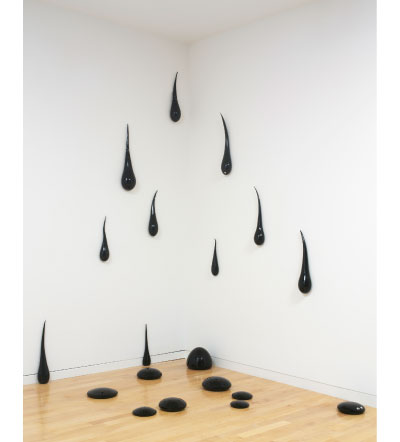
Viscous Rain, Fred Wilson. 2002 Photograph by Ellen Labenski, courtesy PaceWildenstein, New York

Rapper, actor, author, television host, reserve policeman, Twitter megastar, and, yes, basketball legend, Shaquille O’Neal is perhaps the consumate populist Rennaissance man. This month he extends his reach with a new role as curator and muse for the much-buzzed about art show Size DOES Matter at Chelsea’s FLAG Art Foundation. The show, which sets out to display work where size is a central component, boasts an impressive catalogue of artists — Jeff Koons, Anselm Kieffer, Cindy Sherman, Chuck Close, and forty others — and offers an excellent opportunity to experience some fantastic pieces. Whether or not these pieces deal with size is a separate matter.
Shaq personally selected or commissioned the artwork from a list put together by FLAG, and his choices range from pinhead-size sculptures of the First Family to wall-size paintings of body parts, rap stars, and dead Chinese dictators. Highlights include Kieffer’s portrait of a young Mao, a masterful example of the artist’s thick impasto; Koons’ “Beach House”, a frenetically erotic pastiche of swimsuits, deck chairs, and breasts; and Richard Dupont’s lifesize sculptures of himself that play with twisting perspective. A nine-foot-tall photograph of Madonna and her audience, taken from afar, demonstrates each person’s insignificance, while nearby, a collossal sculpture of a table and chairs inspires feelings of childlike joy and awe.
(more…)

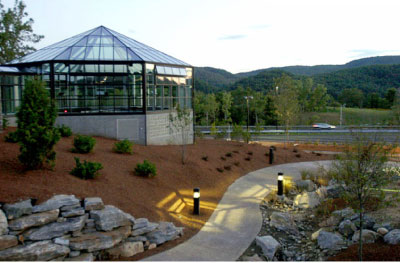
Photography Courtesy of John Todd Ecological Design


Ecological design technology is based on the idea that manmade “machines” can be harnessed to mimic biological systems, giving us the power to restore environmental contaminants and neutralize the build-up of waste on the planet.
John Todd, a marine-biologist, inventor, and designer, is using eco-technology to address the global wastewater crisis. Todd applies principles of bio-mimicry to create Eco-Machines, which are networks of biological systems built to strategically transform industrial sewage into usable water. Eco-Machines are custom built for size requirements, but they all look like a series of connected fish tanks, each tank a separate treatment zone utilizing anaerobic, flow-equalization, anoxic, and aerobic processes. Water flows through the tanks and sifts lastly through an effluent filter, such as a constructed wetland or fluidized bed, to catch leftover solids. All of this is accomplished without the use of chemical-based inputs that are used in sewage treatment plants, which eject chemically imbalanced water back into water streams, starving our rivers of oxygen with unwanted algal blooms.
Living Machines are built to recreate the complexity of ecosystem relationships, which are fostered between microscopic algae, bacteria, protozoa, fungi, zooplankton, minerals, snails, fishes, and plants.
(more…)
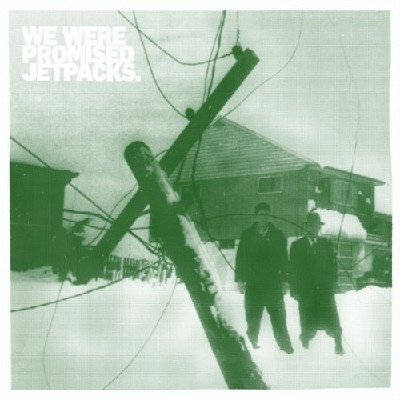
FatCat Records

Last month, we were lucky enough to catch these Scottish upstarts at one of their sold-out New York shows at the new Knitting Factory Brooklyn. Outside, snow may have been falling in large soggy clumps, but the dismal freeze could not stand up to the buzz burning inside. Taking the Williamsburg stage, these four Edinburgh natives looked relatively out of place, more resembling brawny hooligans than the hypersensitive hipsters that constituted their audience. As the band briskly moved through highlights from last year’s debut, These Four Walls, such as “Moving Clocks Run Slow” and “Roll Up Your Sleeves”, thoughts of compatriots and FatCat label-mates the Twilight Sad and Frightened Rabbit were inescapable. But the band’s penchant for angular guitars also evokes comparisons to Bloc Party, while their urgent melodies at times inch toward the terrain of U2’s earliest anthems. This last reference point seems even more suitable with We Were Promised Jetpacks’ new EP, The Last Place You’ll Look, which will hit stores on March 9.
Audio clip: Adobe Flash Player (version 9 or above) is required to play this audio clip. Download the latest version here. You also need to have JavaScript enabled in your browser.
Buy this at Other Music or iTunes.
(more…)
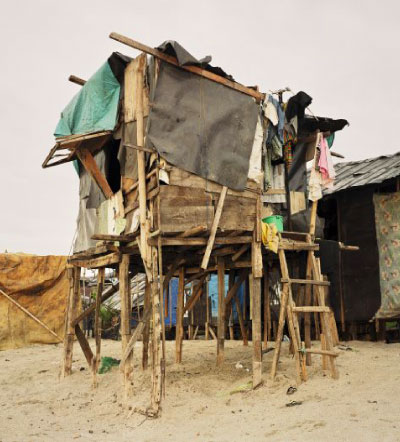
All Photography by Peter Bialobrzeski, courtesy of Hatje Cantz.

Peter Bialobrzeski’s photographs of houses in the informal community of Baseco, Manila, might be especially relevant right now. The small, tilting, wood-framed homes in these pictures, sealed with scraps of fabric, plastic tarps, and posters, are vivid expressions of vulnerability and determination. They remind one of the emergency conditions in Haiti, where thousands of people are currently living in similarly constructed makeshift shelters and, because of cyclical poverty and challenges in rebuilding, could remain indefinitely.
The collection’s title, “Case Study Homes”, refers ironically to the Los Angeles Case Study Houses of the 1950s, a series of modernist prototypes documented in coolly glamorous photographs by Julius Schulman. Bialobrzeski’s photographs don’t have that gloss, of course, but they possess a stately formal beauty that confers dignity on the houses. A diffuse tropical light mutes vivid colors and shadows to give the images a silvery, etched appearance, like Walker Evans’ Depression-era photos. While Evans looked straight into his subject’s faces, however, Bialobrzeski only examines the outside of their homes, a strategy that steers clear of sentimentality. These photographs give straightforward testimony.
(more…)

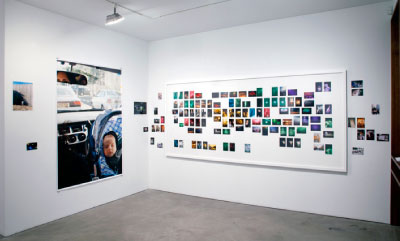
Wolfgang Tillmans, Installation View. (Photography courtesy of Andrea Rosen Gallery)



In this digital age dominated by free media-sharing and instant mobile uploads, photographer Wolfgang Tillmans restores hope in our fading ability to discern beautiful images. German-born Tillmans, known for his rapturous club photos of British i-D, brings to Andrea Rosen Gallery through March 13 a show with the full intensity and point-and-shoot bravura of those seminal nineties spreads. Pictures in the Place of Others, featuring seemingly extemporaneous snapshots of contemporary life, captures tender expressions, natural phenomena, and shimmering skylines. Witness Heptathlon, wherein Tillmans catches an athlete in momentary abandonment; in Ostgut/December Edit (at the entryway of the installation) he assembles chaos with signature panache. When so many photographs bear the markings of deliberation, Tillmans’ appear purely spontaneous. His work thus retains a captivating, timeless quality (perhaps accounting for the unlikely correlations drawn between his irreverent hipster and the Caravaggio nude). An exercise in unkept formalism, Pictures in the Place of Others finds balance in its unapologetic use of color and premeditated, if imperceptible, exhibition layout.
“In a way, to reconcile or address the randomness of the world today is the biggest task, to let it all in, but still hold course…. I’m interested in the mind being stretched by trying to pull this world of pictures together.”
(more…)

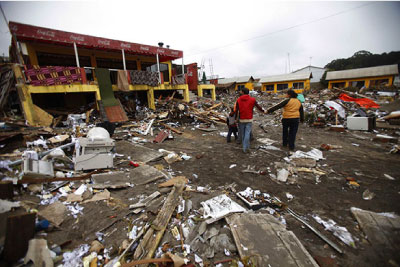
Photography by Roberto Candia/AP via The Guardian UK


Almost fifty years since Chile’s 1960 Valdivia earthquake, history’s largest ever recorded at 9.5, a shattering 8.8 shakedown left Concepcion and the surrounding regions in ruin this past weekend. Yet another coastal calamity that shook Chile at it’s core in Santiago, the devastating blow is significant to Latin America as a whole and will have deep effects in the years to come. Concepcion, the second largest city south of Santiago, was considered by many to be the hub of the country’s progress, known mainly for its industry and education. Although the Chilean people have suffered 711 deaths thus far, according to the Associated Press, they were spared the unimaginable magnitude of death and destruction that has affected Haiti since its earthquake over a month ago. This is due to the country’s past experiences with earthquakes, its preparedness for future ones, stronger building codes and higher construction standards. Of course this has much to do with the vast differences between wealth and poverty in the two countries. Even so, there is tremendous humanitarian need in Chile with over two million people displaced from their homes across a much broader geographical area, and this should not be overlooked by the international community. Nearly 100 aftershocks have hampered the relief effort at this point, but rescue workers are doing everything they can. President Michelle Bachelete has assigned military troops to the rescue, and a curfew is being enforced in an effort to keep looting at bay.
(more…)

Photography courtesy of © Jiri Rezac / WWF-UK (Click on Images to Enlarge)

While the world’s attention has been focused upon Canada for the Winter Olympics, another northerly site worth noting has continued to be widely ignored. Far from gold medal glory, the oil sands in northern Alberta continue to be dug up, mined, steamed, and refined in what many have claimed to be the most environmentally damaging process on earth.
The “tar sands”, as they’re most widely known, refer to bitumen (a dense, degraded form of oil) deposits that lie in the earth’s uppermost layers, heavily mixed together with sand. This form of petroleum is difficult to mine and even more difficult to refine into a usable form. The sands are such an expensive source of oil that it wasn’t until the 1990s that technology had advanced enough for the project to be economically viable. But with the reality of peak oil looming, the sands are now mined in earnest.
One million barrels are currently culled each day from the sands (of which 80 percent goes to the US) and each barrel requires cutting down forest, the removal of two tons of earth to reach the sands, and the removal of two tons of the sand itself. The whole process unleashes five times more greenhouse gases into the atmosphere than normal oil mining. Not only that, but barrels of water are used in the refining process to steam the bitumen from the sand, and the contaminated water left over is dumped into tailings ponds, which, as of a year ago, covered around 50 square miles.
(more…)

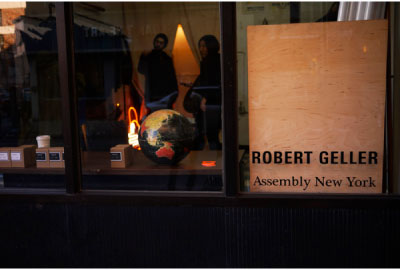


These days Robert Geller, a New York-based menswear designer, is busier than ever, which is just the way he likes it. Besides his successful eponymous line and a collaboration with Levi’s, Geller is launching a new retail venture, called Key Shop. The temporary store, a partnership between Geller and Greg Armas, the owner of the eclectic Lower East Side boutique Assembly, will feature a carefully edited selection of Geller’s products, many exclusive to the store.
Geller has quietly become a fashion fixture of the downtown scene, his slim and pale dandy aesthetic fitting well with skinny dudes of unspecified occupations that roam the streets below Houston and well east of Broadway. “I feel that the Lower East side is where the Robert Geller guy likes to be,” wrote Geller in an email message. “The area has a lot of stores and restaurants popping up, and is still developing nicely. The guys (and girls) there get our aesthetic and will understand the store. I feel like it is the most exciting area of New York right now.”
So, if you want your key (get it?!) Geller items, like a poncho made of cupro and cotton and suede ankle boots, they will be waiting for you at 129 Rivington St., but only until April 15, when the temporary shop will close its doors.
(more…)

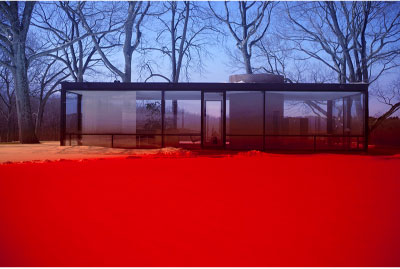
Courtesy Regen Projects, Los Angeles © James Welling


Our image of modern architecture is black and white, quite literally. It’s an image of black ribbon windows in white stucco walls, of slender steel columns behind clear panes of glass. James Welling’s contemporary photographs of architect Philip Johnson’s 1949 Glass House, on display now unitl March 6 at Regen Projects, richly confuse this image.
Welling has captured the house, a landmark of American modernism, with a digital camera and handheld lenses in a series of layered, intensely colored photographs. The prints in the show offer a view of the building that’s tactile, textured, and surprisingly tender.
Most canonical photographs of the house look on it orthogonally, so that its glass skin seems to disappear and its entire structure to dissolve into its manicured surroundings. Welling shoots slightly eccentric perspectives that take in more of the glass and the landscape, and complicates these views by layering them with fields of strong color. This treatment brings out the stubborn physicality of the building. Immense red and green sunspots mottle a glass wall. An orange-colored spill of light reveals the rough surface of an interior carpet.
(more…)
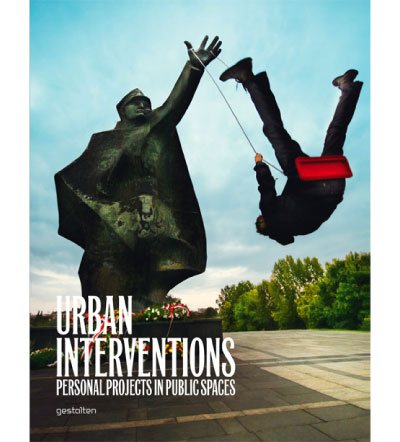
Courtesy of Gestalten Books

I first witnessed urban interventionism at an intersection in La Serena, Chile in 2009. I watched transfixed as a young performer expertly juggled five plastic pins in the middle of the road. He completed his routine and gave a quick bow before darting quickly from one car window to the next, collecting money from drivers’ outstretched hands, jumping back onto the sidewalk seconds before the light turned green again. Though this is a loose example of public art, during the course of my travels through Chile and Argentina, I witnessed beat boxers, mimes, dance troupes and cheerleaders all with the same technique, using the intersection as their stage.
Urban Interventions: Personal Projects in Public Places, due out this March, could very well turn the new art movement into a household word. A creative conglomerate of graffiti, activism, and found street art, the book pays tribute to the most exciting wave of artwork to hit public spaces since Banksy took Bristol by storm in the late ’90s. Urban interventions use ordinary outdoor components to transform everyday landscapes into interactive artwork for the masses. As a result, alleyways become galleries, bus stops morph into studios, and street signs act as canvases.
(more…)





 Facebook
Facebook Permalink
Permalink Digg
Digg Reddit
Reddit LinkedIn
LinkedIn StumbleUpon
StumbleUpon Tumblr
Tumblr
















